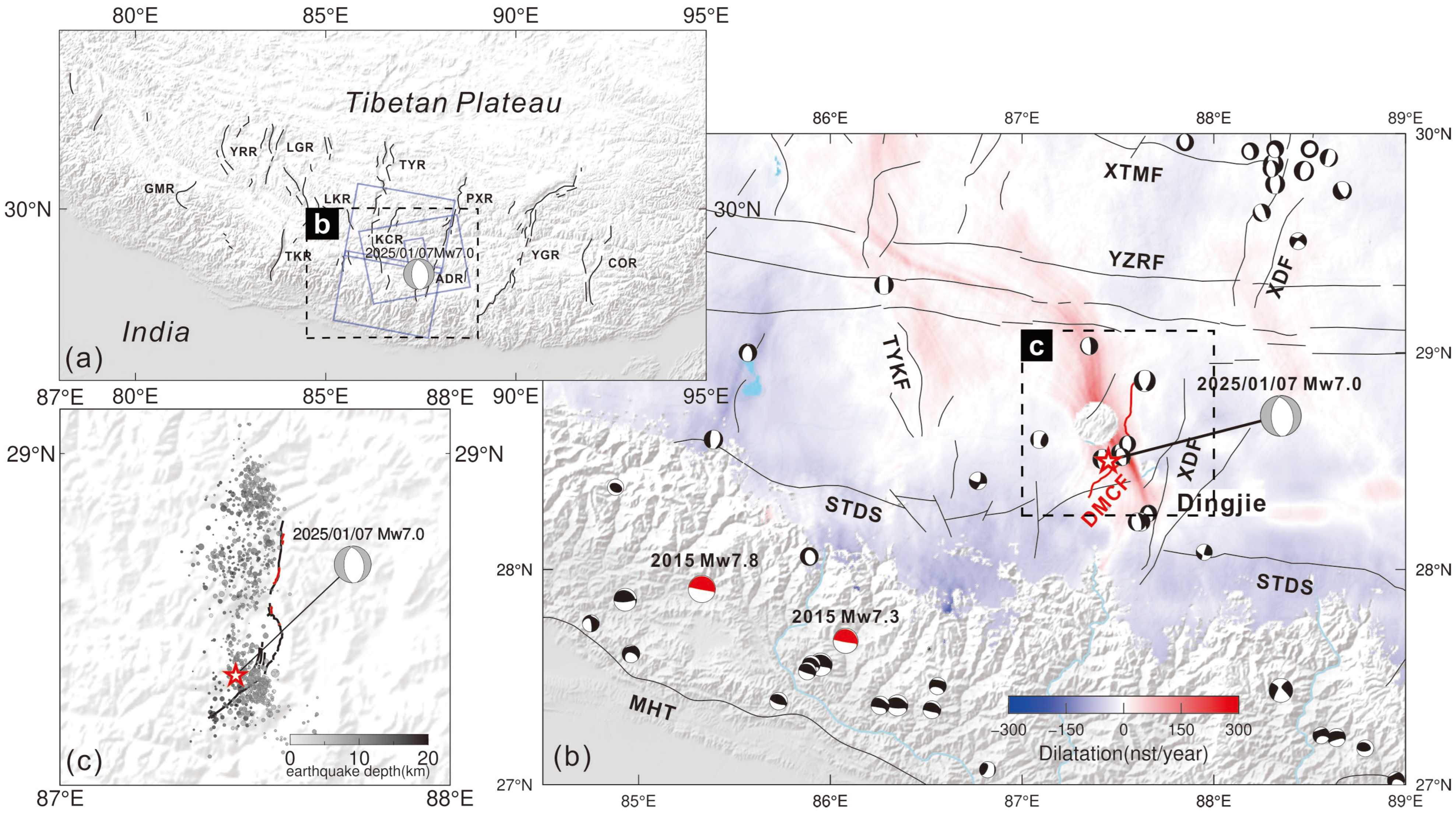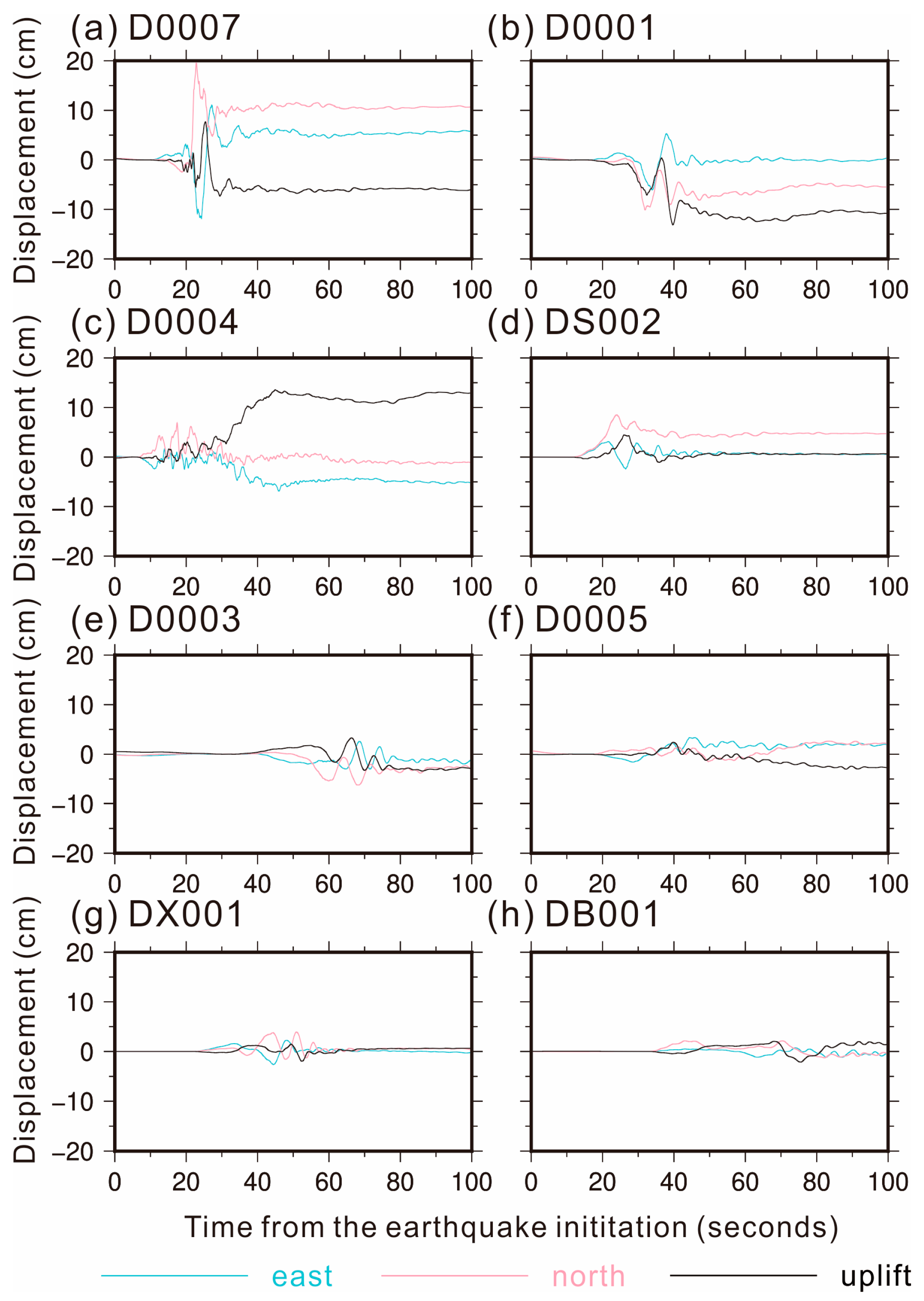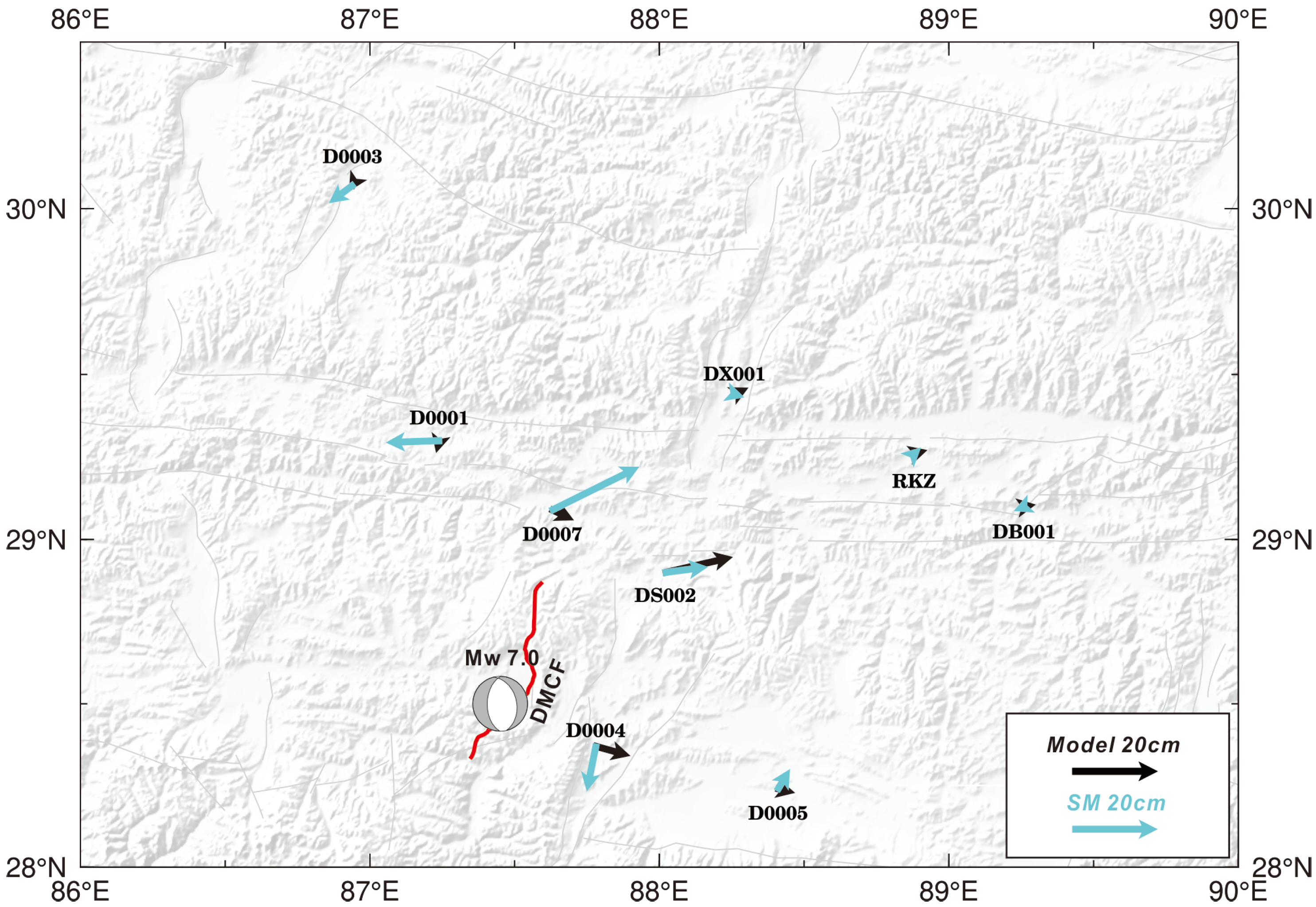Geodetic Observations and Seismogenic Structures of the 2025 Mw 7.0 Dingri Earthquake: The Largest Normal Faulting Event in the Southern Tibet Rift
Abstract
:1. Introduction
2. Materials and Methods
2.1. Tectonic Setting
2.2. D-InSAR Data Processing and Coseismic Deformation Field
2.3. Horizontal Deformation Field
3. Finite-Fault Slip Modeling
4. Discussion
4.1. Causes of Near-Field Decorrelation and Unwrapping Issues
4.2. Reconciling the Slip Distribution, Aftershocks, and the Field Surface Ruptures
4.3. Seismogenic Structure of the Mw 7.0 Dingri Earthquake
5. Conclusions
Author Contributions
Funding
Data Availability Statement
Acknowledgments
Conflicts of Interest
References
- Chen, H.; Qu, C.; Zhao, D.; Shan, X.; Li, C.; Dal Zilio, L. Large-Scale Extensional Strain in Southern Tibet From Sentinel-1 InSAR and GNSS Data. Geophys. Res. Lett. 2024, 51, e2024GL110512. [Google Scholar] [CrossRef]
- Elliott, J.R.; Jolivet, R.; González, P.J.; Avouac, J.-P.; Hollingsworth, J.; Searle, M.P.; Stevens, V.L. Himalayan Megathrust Geometry and Relation to Topography Revealed by the Gorkha Earthquake. Nat. Geosci. 2016, 9, 174–180. [Google Scholar] [CrossRef]
- Yue, C.; Qu, C.Y.; Li, X.F.; Meng, L.Y.; Jiang, X.H.; Wu, D.L. Co- and Postseismic Stress Transfer on Different Types of Faults in Southern Tibet by the 2015 Mw7.8 Gorkha Earthquake. J. Struct. Geol. 2025, 191, 105336. [Google Scholar] [CrossRef]
- Li, Q.; Li, C.T.; Zhao, B.; Huang, Y.; Wan, Y.G.; Tan, K.; Dong, Q. Estimated Seismic Source Parameters for 2020 Dingri Mw5.6 Earthquake in Xizang and Study on the Stress Triggering. Chin. J. Geophys. 2024, 67, 172–188. [Google Scholar] [CrossRef]
- Shi, F.; Liang, M.-J.; Luo, Q.-X.; Qiao, J.-X.; Zhang, D.; Wang, X.; Yi, W.-X.; Zhang, J.-W.; Zhang, Y.-F.; Zhang, H.-P.; et al. Seismogenic Fault and Coseismic Surface Deformation of the Dingri Ms 6.8 Earthquake in Tibet, China. Seismol. Geol. 2025, 47, 1–15. [Google Scholar] [CrossRef]
- Burchfiel, B.C.; Zhiliang, C.; Hodges, K.V.; Yuping, L.; Royden, L.H.; Changrong, D.; Jiene, X. The South Tibetan Detachment System, Himalayan Orogen: Extension Contemporaneous with and Parallel to Shortening in a Collisional Mountain Belt; Burchfiel, B.C., Chen, Z., Hodges, K.V., Liu, Y., Royden, L.H., Deng, C., Xu, J., Eds.; Geological Society of America: Boulder, CO, USA, 1992; Volume 269, ISBN 978-0-8137-2269-6. [Google Scholar]
- Kellett Dawn, A.; Cottle John, M.; Larson Kyle, P. The South Tibetan Detachment System: History, Advances, Definition and Future Directions. Geol. Soc. Lond. Spec. Publ. 2019, 483, 377–400. [Google Scholar] [CrossRef]
- Chen, W.-P.; Yang, Z. Earthquakes Beneath the Himalayas and Tibet: Evidence for Strong Lithospheric Mantle. Science 2004, 304, 1949–1952. [Google Scholar] [CrossRef]
- Molnar, P.; Chen, W.-P. Focal Depths and Fault Plane Solutions of Earthquakes under the Tibetan Plateau. J. Geophys. Res. Solid Earth 1983, 88, 1180–1196. [Google Scholar] [CrossRef]
- Liang, X.; Zhou, S.; Chen, Y.J.; Jin, G.; Xiao, L.; Liu, P.; Fu, Y.; Tang, Y.; Lou, X.; Ning, J. Earthquake Distribution in Southern Tibet and Its Tectonic Implications. J. Geophys. Res. Solid Earth 2008, 113, B12409. [Google Scholar] [CrossRef]
- Molnar, P.; Lyon-Caent, H. Fault Plane Solutions of Earthquakes and Active Tectonics of the Tibetan Plateau and Its Margins. Geophys. J. Int. 1989, 99, 123–153. [Google Scholar] [CrossRef]
- Ni, J.; Barazangi, M. Seismotectonics of the Himalayan Collision Zone: Geometry of the Underthrusting Indian Plate beneath the Himalaya. J. Geophys. Res. Solid Earth 1984, 89, 1147–1163. [Google Scholar] [CrossRef]
- Armijo, R.; Tapponnier, P.; Mercier, J.L.; Han, T.-L. Quaternary Extension in Southern Tibet: Field Observations and Tectonic Implications. J. Geophys. Res. Solid Earth 1986, 91, 13803–13872. [Google Scholar] [CrossRef]
- Sundell, K.E.; Taylor, M.H.; Styron, R.H.; Stockli, D.F.; Kapp, P.; Hager, C.; Liu, D.; Ding, L. Evidence for Constriction and Pliocene Acceleration of East-West Extension in the North Lunggar Rift Region of West Central Tibet. Tectonics 2013, 32, 1454–1479. [Google Scholar] [CrossRef]
- Chen, Q.; Freymueller, J.T.; Yang, Z.; Xu, C.; Jiang, W.; Wang, Q.; Liu, J. Spatially Variable Extension in Southern Tibet Based on GPS Measurements. J. Geophys. Res. Solid Earth 2004, 109, B09401. [Google Scholar] [CrossRef]
- Larson, K.M.; Bürgmann, R.; Bilham, R.; Freymueller, J.T. Kinematics of the India-Eurasia Collision Zone from GPS Measurements. J. Geophys. Res. Solid Earth 1999, 104, 1077–1093. [Google Scholar] [CrossRef]
- Molnar, P.; Tapponnier, P. Active Tectonics of Tibet. J. Geophys. Res. Solid Earth 1978, 83, 5361–5375. [Google Scholar] [CrossRef]
- Chevalier, M.-L.; Tapponnier, P.; van der Woerd, J.; Leloup, P.H.; Wang, S.; Pan, J.; Bai, M.; Kali, E.; Liu, X.; Li, H. Late Quaternary Extension Rates Across the Northern Half of the Yadong-Gulu Rift: Implication for East-West Extension in Southern Tibet. J. Geophys. Res. Solid Earth 2020, 125, e2019JB019106. [Google Scholar] [CrossRef]
- Chen, Q.; Freymueller, J.T.; Wang, Q.; Yang, Z.; Xu, C.; Liu, J. A Deforming Block Model for the Present-Day Tectonics of Tibet. J. Geophys. Res. Solid Earth 2004, 109, B01403. [Google Scholar] [CrossRef]
- Gan, W.; Zhang, P.; Shen, Z.-K.; Niu, Z.; Wang, M.; Wan, Y.; Zhou, D.; Cheng, J. Present-Day Crustal Motion within the Tibetan Plateau Inferred from GPS Measurements. J. Geophys. Res. Solid Earth 2007, 112, B08416. [Google Scholar] [CrossRef]
- Zhang, X.; Li, Z.; Peng, C.; He, S.; Zhang, Y. A Research Framework for Seismic Slip Distribution Inversion Considering Atmospheric Effects and Deformation Field Downsampling. Int. J. Digit. Earth 2024, 17, 2434654. [Google Scholar] [CrossRef]
- Hager, C.; Stockli, D.F.; Dewane, T.J.; Gehrels, G.; Ding, L. Anatomy and crustal evolution of the central Lhasa terrane (S-Tibet) revealed by investigations in the Xainza rift. In Proceedings of the EGU General Assembly 2009, Vienna, Austria, 19–24 April 2009; p. 11346. [Google Scholar]
- Olen, S.M.; Bookhagen, B.; Hoffmann, B.; Sachse, D.; Adhikari, D.P.; Strecker, M.R. Understanding Erosion Rates in the Himalayan Orogen: A Case Study from the Arun Valley. J. Geophys. Res. Earth Surf. 2015, 120, 2080–2102. [Google Scholar] [CrossRef]
- Kali, E.; Leloup, P.H.; Arnaud, N.; Mahéo, G.; Liu, D.; Boutonnet, E.; Van der Woerd, J.; Liu, X.; Liu-Zeng, J.; Li, H. Exhumation History of the Deepest Central Himalayan Rocks, Ama Drime Range: Key Pressure-Temperature-Deformation-Time Constraints on Orogenic Models. Tectonics 2010, 29, TC2014. [Google Scholar] [CrossRef]
- Hou, L.; Shan, X.; Gong, W.; Zhang, Y.; Luo, H.; Zhao, D. Characterizing Seismogenic Fault of 2016 Dingjie Earthquake Based on Multitemporal DInSAR. Chin. J. Geophysics 2020, 63, 1357–1369. [Google Scholar] [CrossRef]
- Kellett, D.A.; Grujic, D. New Insight into the South Tibetan Detachment System: Not a Single Progressive Deformation. Tectonics 2012, 31, TC2007. [Google Scholar] [CrossRef]
- Carosi, R.; Lombardo, B.; Molli, G.; Musumeci, G.; Pertusati, P.C. The South Tibetan Detachment System in the Rongbuk Valley, Everest Region. Deformation Features and Geological Implications. J. Asian Earth Sci. 1998, 16, 299–311. [Google Scholar] [CrossRef]
- Tingting, T.; Zhonghai, W. Recent Prehistoric Major Earthquake Event of Dingmucuo Normal Fault in the Southern Segment of Shenzha-Dingjie Rift and Its Seismic Geological Significance. Geol. Rev. 2023, 69, 53–55. [Google Scholar] [CrossRef]
- Rosen, P.A.; Hensley, S.; Joughin, I.R.; Li, F.K.; Madsen, S.N.; Rodriguez, E.; Goldstein, R.M. Synthetic Aperture Radar Interferometry. Proc. IEEE 2000, 88, 333–382. [Google Scholar] [CrossRef]
- Rodriguez, E.; Morris, C.S.; Belz, J.E.; Chapin, E.; Martin, J.; Daffer, W.; Hensley, S. An Assessment of the SRTM Topographic Products; Technical Report JPL D-31639; Jet Propulsion Laboratory: Pasadena, CA, USA, 2005.
- Werner, C.; Wegmüller, U.; Strozzi, T.; Wiesmann, A. Processing strategies for phase unwrapping for INSAR applications. In Proceedings of the European Conference on Synthetic Aperture Radar EUSAR 2002, Cologne, Germany, 4–6 June 2002; Gamma Remote Sensing AG: Muri bei Bern, Switzerland, 2002; Volume 1, pp. 353–356. [Google Scholar]
- Zang, J.; Xu, C.; Chen, G.; Wen, Q.; Fan, S. Real-Time Coseismic Deformations from Adaptively Tight Integration of High-Rate GNSS and Strong Motion Records. Geophys. J. Int. 2019, 219, 1757–1772. [Google Scholar] [CrossRef]
- Wang, R.; Schurr, B.; Milkereit, C.; Shao, Z.; Jin, M. An Improved Automatic Scheme for Empirical Baseline Correction of Digital Strong-Motion Records. Bull. Seismol. Soc. Am. 2011, 101, 2029–2044. [Google Scholar] [CrossRef]
- Wang, R.; Motagh, M.; Walter, T. Inversion of Slip Distribution from Coseismic Deformation Data by a Sensitivity-Based Iterative Fitting (SBIF) Method. EGU Gen. Assem. 2008, 10, EGU2008-A-07971. [Google Scholar]
- Okada, Y. Surface Deformation Due to Shear and Tensile Faults in a Half-Space. Bull. Seismol. Soc. Am. 1985, 75, 1135–1154. [Google Scholar] [CrossRef]
- Yu, C.; Li, Z.; Hu, X.; Song, C.; Li, S.; Liu, H.; Li, J.; Han, B.; Liu, Z.; Liu, M.; et al. Source Parameters and Induced Hazards of the 2025 Mw 7.1 Dingri Earthquake on the Southern Tibetan Plateau (Xizhang), China, as Revealed by Imaging Geodesy. J. Earth Sci. 2025. [Google Scholar] [CrossRef]
- Zhao, C.; Qu, F.; Zhang, Q.; Zhu, W. A Combined Multi-Interferogram Algorithm for High Resolution DEM Reconstruction over Deformed Regions with TerraSAR-X Data. J. Geodyn. 2012, 61, 148–153. [Google Scholar] [CrossRef]
- Das, S.; Henry, C. Spatial Relation between Main Earthquake Slip and Its Aftershock Distribution. Rev. Geophys. 2003, 41, 1013. [Google Scholar] [CrossRef]
- Gallovič, F.; Zahradník, J.; Plicka, V.; Sokos, E.; Evangelidis, C.; Fountoulakis, I.; Turhan, F. Complex Rupture Dynamics on an Immature Fault during the 2020 Mw 6.8 Elazığ Earthquake, Turkey. Commun. Earth Environ. 2020, 1, 40. [Google Scholar] [CrossRef]
- Rietbrock, A.; Ryder, I.; Hayes, G.; Haberland, C.; Comte, D.; Roecker, S.; Lyon-Caen, H. Aftershock Seismicity of the 2010 Maule Mw=8.8, Chile, Earthquake: Correlation between Co-Seismic Slip Models and Aftershock Distribution? Geophys. Res. Lett. 2012, 39, L08310. [Google Scholar] [CrossRef]
- Toda, S.; Stein, R.S. Central Shutdown and Surrounding Activation of Aftershocks from Megathrust Earthquake Stress Transfer. Nat. Geosci. 2022, 15, 494–500. [Google Scholar] [CrossRef]
- Toda, S.; Stein, R.S.; Sevilgen, V.; Lin, J. Coulomb 3.3 Graphic-Rich Deformation and Stress-Change Software for Earthquake, Tectonic, and Volcano Research and Teaching-User Guide; USGS: Reston, VA, USA, 2011.
- Li, C.; Li, T.; Shan, X.; Zhang, G. Extremely Large Off-Fault Deformation during the 2021 Mw 7.4 Maduo, Tibetan Plateau, Earthquake. Seismol. Res. Lett. 2022, 94, 39–51. [Google Scholar] [CrossRef]
- Oskin, M.E.; Arrowsmith, J.R.; Corona, A.H.; Elliott, A.J.; Fletcher, J.M.; Fielding, E.J.; Gold, P.O.; Garcia, J.J.G.; Hudnut, K.W.; Liu-Zeng, J.; et al. Near-Field Deformation from the El Mayor–Cucapah Earthquake Revealed by Differential LIDAR. Science 2012, 335, 702–705. [Google Scholar] [CrossRef]
- Bird, P. Long-Term Fault Slip Rates, Distributed Deformation Rates, and Forecast of Seismicity in the Western United States from Joint Fitting of Community Geologic, Geodetic, and Stress Direction Data Sets. J. Geophys. Res. Solid Earth 2009, 114, B11403. [Google Scholar] [CrossRef]
- Wessel, P.; Luis, J.F.; Uieda, L.; Scharroo, R.; Wobbe, F.; Smith, W.H.F.; Tian, D. The Generic Mapping Tools Version 6. Geochem. Geophys. Geosyst. 2019, 20, 5556–5564. [Google Scholar] [CrossRef]







| Scheme | Longitude (◦) | Latitude (◦) | Depth (km) | Strike (◦) | Dip (◦) | Rake (◦) | Mw |
|---|---|---|---|---|---|---|---|
| GCMT | 87.47 | 28.56 | 12 | 356/173 | 42/48 | −88/−92 | 7.1 |
| USGS | 87.361 | 28.639 | 11.5 | 349/187 | 42/49 | −103/−78 | 7.05 |
| GFZ | 87.41 | 28.57 | 14 | 164/1 | 41/50 | −103/−79 | 7.07 |
| IPGP | 87.361 | 28.639 | 14 | 341/196 | 51/44 | −113/−64 | 7.16 |
| CENC | 87.45 | 28.5 | 10 | 348/181 | 40/51 | −100/−81 | 7.1 |
| Sensor | Acquisition Time | Orbital Direction | Path |
|---|---|---|---|
| Sentinel-1A | 2025/1/5–2025/1/17 | Ascending | 12 |
| 2025/1/1–2025/1/13 | Descending | 121 | |
| Lutan | 2024/12/6–2025/1/7 | Ascending | - |
Disclaimer/Publisher’s Note: The statements, opinions and data contained in all publications are solely those of the individual author(s) and contributor(s) and not of MDPI and/or the editor(s). MDPI and/or the editor(s) disclaim responsibility for any injury to people or property resulting from any ideas, methods, instructions or products referred to in the content. |
© 2025 by the authors. Licensee MDPI, Basel, Switzerland. This article is an open access article distributed under the terms and conditions of the Creative Commons Attribution (CC BY) license (https://creativecommons.org/licenses/by/4.0/).
Share and Cite
Liu, Q.; Hua, J.; Zhang, Y.; Gong, W.; Zang, J.; Zhang, G.; Li, H. Geodetic Observations and Seismogenic Structures of the 2025 Mw 7.0 Dingri Earthquake: The Largest Normal Faulting Event in the Southern Tibet Rift. Remote Sens. 2025, 17, 1096. https://doi.org/10.3390/rs17061096
Liu Q, Hua J, Zhang Y, Gong W, Zang J, Zhang G, Li H. Geodetic Observations and Seismogenic Structures of the 2025 Mw 7.0 Dingri Earthquake: The Largest Normal Faulting Event in the Southern Tibet Rift. Remote Sensing. 2025; 17(6):1096. https://doi.org/10.3390/rs17061096
Chicago/Turabian StyleLiu, Qingyi, Jun Hua, Yingfeng Zhang, Wenyu Gong, Jianfei Zang, Guohong Zhang, and Hongyi Li. 2025. "Geodetic Observations and Seismogenic Structures of the 2025 Mw 7.0 Dingri Earthquake: The Largest Normal Faulting Event in the Southern Tibet Rift" Remote Sensing 17, no. 6: 1096. https://doi.org/10.3390/rs17061096
APA StyleLiu, Q., Hua, J., Zhang, Y., Gong, W., Zang, J., Zhang, G., & Li, H. (2025). Geodetic Observations and Seismogenic Structures of the 2025 Mw 7.0 Dingri Earthquake: The Largest Normal Faulting Event in the Southern Tibet Rift. Remote Sensing, 17(6), 1096. https://doi.org/10.3390/rs17061096






